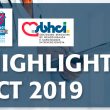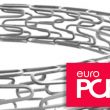Courtesy of Dr. Carlos Fava. Chronic total occlusions (CTO) are still one of the greatest challenges in our field, thus forcing the development of different complex strategies to resolve them. Additionally, the use of imaging techniques during these procedures has improved long-term results. The CONSISTENT CTO (Conventional Antegrade Versus Sub-Intimal Synergy Stenting in Chronic Total Occlusions)<a href="https://solaci.org/en/2020/07/17/subintimal-re-entry-in-cto-improves-outcomes/" title="Read more" >...</a>
TCT 2019 | EVOLVE Short DAPT: Only 3-month DATP in High Risk Bleeding
Courtesy of the SBHCI. This study used the thin strut everolimus eluting stent with ultrathin abluminal bioresorbable polymer coating chromium platinum stent, basically the Synergy stent. Drug release and polymer degradation within four months facilitate endothelization and would allow a shorter DAPT. Presented during the scientific sessions of TCT 2019, this study included 2009 high<a href="https://solaci.org/en/2019/09/30/tct-2019-evolve-short-dapt-only-3-month-datp-in-high-risk-bleeding/" title="Read more" >...</a>
TCT 2019 | IDEAL-LM: Bioabsorbable Polymer DES vs. Permanent Polymer DES for Left Main Stenosis
Courtesy of SBHCI. This study showed that using the everolimus eluting stent with bioabsorbable polymer Synergy followed by 4 months of dual antiplatelet therapy (DAPT) to treat left main stenosis (LMS) was safe and effective, compared against using the everolimus eluting stent with permanent polymer Xience followed by the conventional 12 months DAPT. This study<a href="https://solaci.org/en/2019/09/30/tct-2019-ideal-lm-bioabsorbable-polymer-des-vs-permanent-polymer-des-for-left-main-stenosis/" title="Read more" >...</a>
Do Polymers Play any Role in Drug Eluting Stents
The fact that polymers can degrade after drug release seems interesting, more so when there appears to be evidence that they might cause inflammation (manly eosinophil infiltration) given its unwanted consequences. However, nice theories often get a reality check, and the polymer discussion is no exception. This article, soon to be published in J Am<a href="https://solaci.org/en/2019/09/25/do-polymers-play-any-role-in-drug-eluting-stents/" title="Read more" >...</a>
Thin, Very Thin, and Ultrathin Struts, with Permanent or Biodegradable Polymer… Which Is the Best Combination?
Results from the BIO-RESORT trial at three years, soon to be published in JACC Intv., show that, despite significant differences among stents as regards strut thickness and capability to reabsorb the polymer, there are no apparent safety or efficacy differences among devices. The aim of this study was to determine the three-year safety and efficacy<a href="https://solaci.org/en/2019/09/18/thin-very-thin-and-ultrathin-struts-with-permanent-or-biodegradable-polymer-which-is-the-best-combination/" title="Read more" >...</a>
Permanent Carotid Coil Filters in Patients with Atrial Fibrillation
This new strategy to reduce the risk of stroke in patients with atrial fibrillation is technically feasible and safe, even though long-term outcomes are yet to be seen and despite the evidence available, for instance, left atrial appendage closure devices. It is true that they could be used simultaneously, but its synergy and cost have<a href="https://solaci.org/en/2019/08/29/permanent-carotid-coil-filters-in-patients-with-atrial-fibrillation/" title="Read more" >...</a>
EuroPCR 2019 | BIO-RESORT and SCAAR Registry: Ultrathin Struts Also in Small Vessels pequeños
Data from randomized studies are also supported by the SCAAR registry, in which ultrathin-strut stents show real-world advantages. Patients with small vessels who received ultrathin-strut stents are less likely to undergo revascularization at 3 years than those who received first-generation thin-strut devices, according to the BIO-RESORT trial, presented during the first day of the annual<a href="https://solaci.org/en/2019/05/23/europcr-2019-bio-resort-and-scaar-registry-ultrathin-struts-also-in-small-vessels-pequenos/" title="Read more" >...</a>
The Most Read Articles of March in Interventional Cardiology
1- What to Do with Blood Pressure Levels Between 130/80 and 139/89 mmHg The decision to be made with a treatment-free patient with systolic blood pressure over 160 mmHg or diastolic blood pressure over 100 mmHg is an easy one. All guidelines agree: treatment should be started immediately alongside lifestyle changes. Read more 2-<a href="https://solaci.org/en/2019/04/22/the-most-read-articles-of-march-in-interventional-cardiology/" title="Read more" >...</a>
ACC 2019 | SMART-CHOICE: Aspirin Increasingly “Against the Ropes”
This work (presented during the same American College of Cardiology [ACC] 2019 Scientific Session as the STOPDAPT-2 trial) enrolled 2993 patients who underwent angioplasty with current-generation stents Xience, Promus, Synergy, or Orsiro at 33 Korean sites. Patients were randomized to 12 months of dual antiplatelet therapy or dropping aspirin at 3 months. There was no difference between the short-<a href="https://solaci.org/en/2019/03/25/acc-2019-smart-choice-aspirin-increasingly-against-the-ropes/" title="Read more" >...</a>
Clinical Improvement Without Ventricular Function Improvement After CTO
The benefits offered to patients by attempting the rechanneling of a chronic total occlusion are still unclear. Additionally, sometimes the procedural risks are somewhat undetermined. Taking into account these controversies, this work sought to prove whether successful rechanneling of a chronic total occlusion improves ventricular function. This is not a soft endpoint; it has been<a href="https://solaci.org/en/2018/11/23/clinical-improvement-without-ventricular-function-improvement-after-cto/" title="Read more" >...</a>







